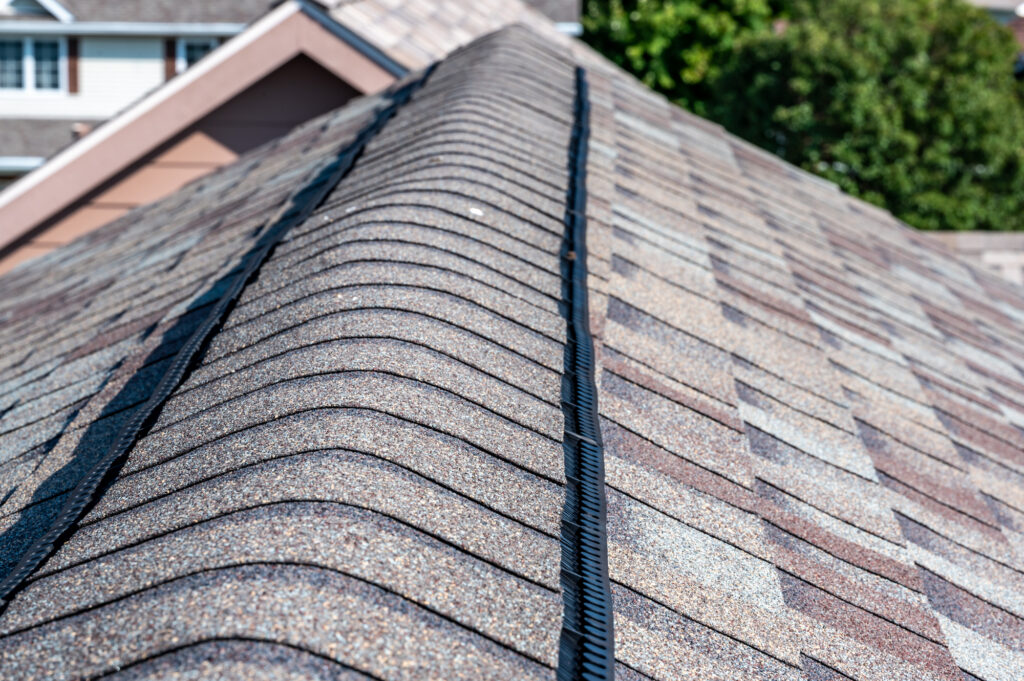At Ranch Roofing, we know how important ventilation is for the longevity of your roof and the overall environment of your home. Roof vents, such as ridge vents, help regulate temperature and moisture and support air circulation and quality. Accordingly, they also impact the overall energy efficiency of a home. As shared by the National Association of Realtors®, over 60% of realtors emphasize energy efficiency as an important contributor to property value. Learn more about the importance of ridge vents and the unique aspects of your home that impact your ventilation needs.
What is a ridge vent?
In terms of roof anatomy, the roof ridge is where all of the roofing materials meet, typically at the roof’s peak or highest point of the home. Along these peaks or ridges, you’ll often see ridge vents. This type of roof ventilation is a passive system, meaning that it does not require power or mechanical support to function. Temperature and pressure help move air through these vents, but they are often combined with other ventilation components for a more consistent and effective system of intake and exhaust operation.
There are many options for ridge vents in terms of materials and special features, as well as design. Metal and plastic are popular ridge vent materials because of their ability to withstand weather-related corrosion and their general durability. Some ridge vents incorporate filters to prevent bugs or wind-blown debris from entering into the attic space. Other styles try to leverage the wind for greater airflow or include weather guards to maintain ventilation functions despite the weather from winter snowstorms or spring showers. Ridge vents can be installed in individual units or as a continuous system along the entire roofline. In addition to material selection, certain ridge vents are designed to be almost invisible to the eye. To customize a roofing ventilation system that will work best for your home, it’s important to consult with a residential roofing expert in order to determine the ridge vents and other ventilation options that suit your home’s needs and your personal design preferences.
How do ridge vents contribute to a home’s energy efficiency?
Ridge vents help exhaust air from the home, especially hot humid air. In conjunction with additional roof ventilation features like soffit vents, they can influence a home’s overall energy efficiency. Here’s why:
- Temperature Consistency: When the cooler air comes in through other parts of the ventilation system, the hotter air rises and exits through the ridge vent. Consequently, the home’s internal temperature is less likely to experience continual fluctuations or variability in different locations of the home. Therefore, running the air conditioner won’t raise the energy bills as much, because the cooling system won’t have to work so hard to achieve the desired temperature.
- Passive cooling: Other cooling components require power sources, but ridge vents do not. Consequently, their integration and operation doesn’t require any additional energy resources to be consumed, which helps them lower a home’s overall impact on the environment.
- Insulation and roof integrity: In addition to helping to manage temperature, ridge vents also help move out the kind of humidity that can cause a number of problems including mold growth and air quality concerns. Moisture can also lead to deterioration of both insulation and roofing materials. Prolonged damage to these important components of the home can further exacerbate climate-related temperature control issues.
Factors that influence ridge vent selection and installation
In addition to local building codes or personal preferences, there are a number of other factors to consider when deciding to integrate ridge vents and other ventilation features into the home. The number of ridge vents, for example, depends on the size and layout of the attic. A more sizable attic will likely necessitate a greater number of vents. The design of the roof including its material, pitch and complexity also influences which ridge vents are needed, as well as their size and placement. Finally, environmental features like the area’s specific climate considerations and other existing ventilation within the home impact the selection and installation of ridge vents and comprehensive ventilation system design.
A well-balanced approach to roof ventilation is essential for maximizing its benefits. Efficient and effective roof ventilation requires more than just having a ridge vent or adding an attic fan, which is why discussing a ventilation system with your roofing professionals is so important. If you are thinking about a new roofing installation or other roofing service, now may be the perfect time to improve your home’s ventilation system. Tell us about your roofing and ventilation needs, and the Ranch Roofing team can begin working with you to improve your home’s energy efficiency and overall environment.
